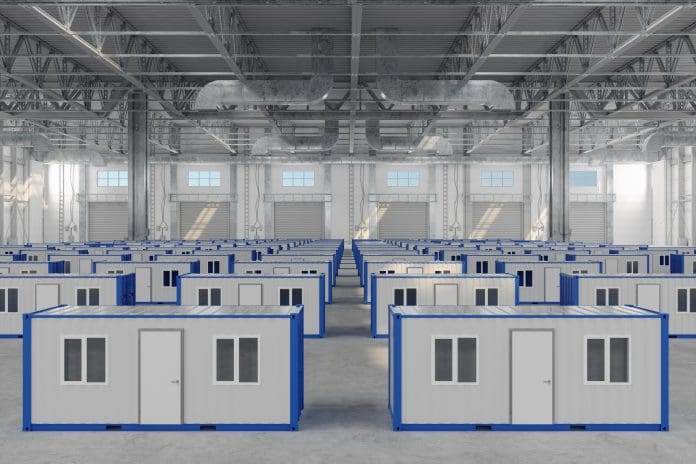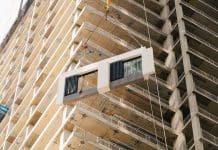In 2022, Des Duddy of Protrade predicted a golden year for modular and offsite – but the promising picture has largely failed to materialise. Despite the setbacks, he explains why he believes the sector still has a big role to play in solving some of construction’s biggest challenges
A couple of years ago, I predicted that 2022 would be a golden year for modular and offsite construction.
The reason I made this prediction is that modular construction was enabling the industry to achieve incredible feats, particularly in China, where a prefabrication business had built a 57-storey building in just 19 days and Huoshenshan Hospital in Wuhan had been constructed in just 10 days in response to the Covid-19 pandemic.
It seemed as though modular could be the answer to many of the issues the UK construction industry is facing, from skills shortages and rising material costs to lack of housing stock.
While in theory modular construction painted a promising picture, the reality hasn’t been as commercially successful as it had seemed it would be. 2022 certainly saw the modular industry rise to its height, with methods being used in 17% of new build projects – up from 9% in 2017 – before dropping to 16% in 2023, but figures released from the UK’s top modular companies show combined losses exceeding £285m over the past few years.
Modular has seen an onslaught of challenges that were not anticipated, such as high fixed costs and unstable production pipelines, which has prevented it from living up to expectations.
But, despite the major setback, I firmly believe modular still has a significant role to play. In this article, we will look at what the industry can learn from the past two years of embedding modular practices and what we need to change moving forward if we want to progress and solve construction’s biggest issues.
The state of modular today
Last year saw major setbacks for the modular construction industry in the UK after huge losses were made by all key players in the market, such as L&G Modular Homes, Ilke Homes and TopHat.
While the concept of modular construction wasn’t new in 2022, production on a mass scale was. The benefits of wide-scale factory production seemed to answer many of the issues the construction industry faced with regard to the housing shortages, but nobody seemed to anticipate the problems the sector would face during initial implementation.
The UK’s sudden jump into the industry, directly after the pandemic, highlighted significant challenges, with factors such as commercially viable output volumes and high fixed costs being major obstacles to conquer.
Modular construction can still make a significant contribution towards solving key issues, providing we understand the limitations and maximise its efficiencies.
Understanding the UK’s commercial challenges with modular
Ultimately, there are several issues currently affecting why modular construction has not been commercially viable so far in the UK. The cost of the overhead is massive, with a huge factory, cranes and a large full-time workforce needed, which doesn’t become viable until production is at
a significant scale.
Additionally, securing a reliable project pipeline is challenging, particularly when there are hold-ups in the planning process as a result of a lack of understanding within local authorities.
The need for high production levels means there’s a lot of over-promising and underachieving when it comes to winning a contract and running a project, and when planning and pipeline issues are piled on to this, companies are often unable to accommodate high fixed costs before the job is finished.
Modular construction is on a completely different playing field in terms of pipeline and production compared with traditional construction, with modular being associated with rapidly building thousands of homes versus the slower and smaller scale of traditional building projects.
Modular construction might still be finding its footing, unaided by a lack of understanding from local councils, which causes delays in planning and hinders production schedules.
There’s certainly still an appetite for modular construction to become successful in the UK, particularly when the industry knows that continuing traditional construction methods is only exacerbating the issues we’re currently facing.
A hybrid solution to construction could be significant
Despite the substantial losses that the first companies venturing into modular have faced, modular construction remains a crucial part of the solution to major challenges plaguing the industry and housing sector.
The Construction Industry Training Body (CITB) estimates that around 45,000 people would need to join the sector every year for the next five years in order to meet the
National Housing Federation’s claim that 340,000 new homes per year need to be delivered across the UK to
address the housing crisis – 145,000 of those being “affordable homes”.
The Conservatives have pledged in their 2024 manifesto that they will build 1.6m homes in England during the next parliament, and Labour has pledged 1.5 million homes in their manifesto.
This equates to 320,000 homes per year in the Conservative’s case and 300,000 in Labour’s, just below the National Housing Federation’s target number of homes needed to solve the crisis.
Modular construction appears to offer an obvious solution in fulfilling either party’s pledge of mass-constructing homes.
On top of that, leveraging the technology used for modular construction will help to automate the labour-intensive processes, while specialised roles provide more interesting career paths.
Raw construction materials saw a huge surge in price between July 2020 and July 2022, and while it’s good news that prices are beginning to settle, costs remain elevated compared with pre-pandemic levels. Modular construction may be able to positively control costs for the industry.
Modular’s success lies in working hand-in-hand with traditional construction
What’s needed is a hybrid solution where traditional construction methods are complemented by modular practices.
The industry has been guilty of overselling modular as the “new way” of building houses, but the reality is, it was never going to replace traditional construction methods fully.
Modular’s strength lies in creating standardised, repetitive elements quickly and efficiently in a controlled setting, but certain bespoke elements are simply better suited for skilled tradespeople working onsite.
This hybrid approach can be applied to something like hotel construction, for example. Modular’s productivity can be utilised to manufacture hundreds of bathroom shower pods in a factory very quickly but then can be integrated into a traditionally built steel frame core and finishings.
We don’t have to pick one over the other, both modular and traditional methods have their strengths and weaknesses.
Significant change and increased construction efficiency will happen when offsite manufacturing for creating the standardised components that drive production schedules combines seamlessly into a hybrid model with traditional onsite crews working on the complex, customised aspects of the project.
The future of modular construction remains promising
The key component holding modular back from being commercially viable at the moment is our inability to accurately quantify what modular construction can realistically deliver.
Once an algorithm is determined that considers square footage, costs and production rates, and gives us a real-world figure for the volume that is commercially viable, more construction companies will be willing to invest.
The hope for modular is that we witness more realistic output claims from huge corporations, legitimising the modular concept and we also see moderate-sized organisations turning to modular to fulfil smaller-scale building projects. That’s when modular construction will become an interesting and attractive proposition for investors again.














